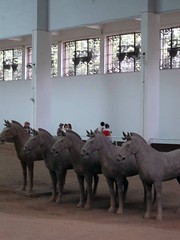The terracotta figures buried with the first Emperor of Qin (Qin Shi Huang) in 210-209 BC were to protect the Emperor in the afterlife, says Wikipedia.org.
- 8,099 life-size terra cotta figures of warriors and horses.
- Located near the Mausoleum of the First Qin Emperor.
- The Terracotta Army was discovered in March 1974.
- Mount Lishan is the name of the man-made necropolis of the First Emperor of the Qin Dynasty; [Qin Shi Huang].
- Construction of this mausoleum began in 246 BC and is believed to have taken 700,000 workers and craftsmen 38 years to complete.
- According to the Grand Historian Sima Qian, the First Emperor was buried alongside great amounts of treasure and objects of craftsmanship, as well as a scale replica of the universe complete with gemmed ceilings representing the cosmos, and flowing mercury representing the great earthly bodies of water. Pearls were also placed on the ceilings in the tomb to represent the stars and planets, etc.
In the army:
- infantry
- archers
- officers
- crouching or standing pose.
- real weapons such as bronze spears, halberds or swords, or wooden crossbows with bronze fittings.
Excavation at the site has shown a fire burned the wooden structures once housing the Terracotta Army. Such a fire is described by Sima Qian as part of the consequences of the raiding General Xiang Yu less than five years after the death of the First Emperor. It is said that the effects of General Xiang’s army included looting of the tomb and structures holding the Terracotta Army, as well as setting fire to the necropolis and starting a blaze that lasted for three months. Despite this fire, however, much of the remains of the Terracotta Army still survive in various stages of preservation, surrounded by remnants of the burnt wooden structures
skip to main |
skip to sidebar
For students and parents who love education and exploration of the social sciences . . .
Search This Blog
Followers
Blog Archive
-
▼
2006
(381)
-
▼
December
(50)
- Expanding our consciousness in Iraq, from the Econ...
- Second semester overview: from the Land of the Ris...
- Camera for Xmas?
- Sample test on the life of Gandhi
- October test / Israel & Arabia with answers
- China review and Essay skills
- Sem Exam: notes from Oct, Nov, Dec
- The list of Chinese inventions is astounding to a ...
- Chinese architecture project - apartments, farmers...
- The Pekingese and the many breeds that originated ...
- Second semester project: making a Chinese dragon f...
- Spiritual head of Tibetan Buddhists, the Dalai Lama
- Aquaculture, another similarity between China and ...
- School drop-outs: do we share the problem with China?
- 101 Tapei: the world's largest steel orb inside th...
- Hawaii & Pearl Harbor: basic background
- 10,000 watch towers, 4,000 miles: the Great Wall
- 8000 life-size figures in the Terra Cotta Army of ...
- Mao Zedong, communist dictator of China from 1949 ...
- House of Flying Daggers was a pop martial arts mov...
- Watching a modern story of China in Mandarin Chine...
- Semester exam: 100 mult-choice questions answered ...
- Ni hau! That's the world's most widely spoken form...
- Why study China: WalMart, US Army, Guitars, Outsou...
- Brief unit on the basics of Washington DC
- Objective accomplished: Class of 2010 Talent Show 06
- Brooke Hightower
- Set design & production: Mason Nabors
- Claire Crosby
- Rachel Young
- Talent show produced by first-years: Caroline Germany
- Doug Pierce & Caroline Germany
- Mac Orchard, lights, Amanda Hock & Eric Coleman, s...
- Alyssa, Diana, Lizzie
- Kaylah, Megan, Mason
- Kaylah Williams, Mason Nabors
- Katy Li
- Andrew Delo, Mason Nabors
- Michelle Khare
- Meredith & Maggie
- Matt Light vs. Andrew Delo
- John Henry Crawford, Arvesh Kompelli
- Kaitlin Williams
- Susan & Diana upon Canon in D
- Fabs, Michelle, Matt, Alyssa, Phillipe, Katy
- Liz Burford, Claire Cook, Maggie Caruthers on top
- Susan Beresko, Megan Shay, Hali Kha
- Maggie Caruthers, Meredith Cupp
- Thanks to veryone who attended and worked on the F...
- Tyler Snelling: Thai curry chicken
-
▼
December
(50)

